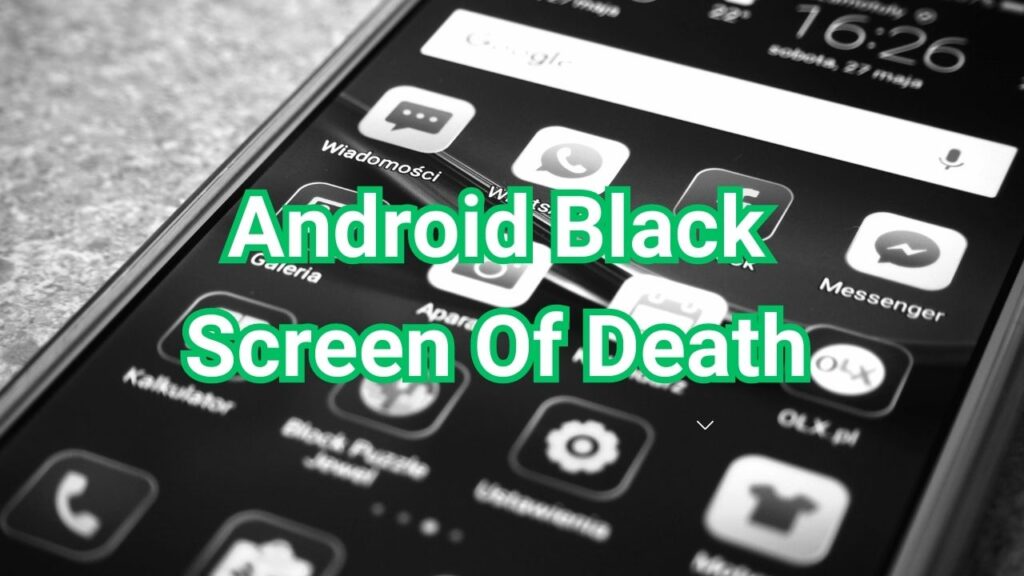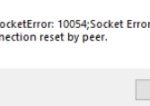Suddenly, the screen on your Android phone turns black, and it won’t respond. No lock screen, no touch response, and even charging it doesn’t seem to wake it up. But don’t panic just yet! Before you go thinking about getting a new phone, let’s explore some ways we might be able to bring your device back to life.

Table of Contents
What is Android Black Screen Of Death?
The “black screen of death” (BSoD) is a hefty problem on an Android device. The screen turns black and becomes unresponsive. It can be due to power or battery problems, glitches in the software, hardware malfunctions, or conflicts with other apps. It’s akin to the “blue screen of death” on Windows PCs, signaling a significant system error.
With the BSoD on Android, the device might ignore any button presses, including power, volume, or touchscreen commands. It might not even turn on, and repair or replacement might be needed.
But let’s not jump to conclusions! Sometimes, there’s a chance to fix this issue yourself.
Troubleshoot Black Screen Issues
Check If Your Screen is Broken
The phone might not be broken, but rather the LCD or OLED screen.
When encountering a situation where your phone’s screen flickers black or you hear sounds without any visual display, it is highly likely that your screen has suffered damage.
In such cases, it is advisable to promptly take your phone to a repair shop for a thorough inspection.
By doing so, you can have a professional assess the extent of the damage and provide appropriate solutions to rectify the issue.
Remember, seeking expert assistance is crucial to ensure the proper functioning and longevity of your device.
Investigate the Phone Battery
If your screen is black, the battery could be the culprit. It’s typically because the screen isn’t receiving any power, or the phone itself is out of power. This problem can be often traced back to a depleted battery, where the phone just needs charging.
- Charge It Up: Plug it in and wait for at least half an hour. It might just need some time to gather enough juice.
- Check the Cable and Adapter: Test them or replace them to rule out faults.
- Inspect the Charging Port: It might be dirty or damaged.
- Professional Evaluation: If all else fails, consult a professional if the battery or power management is broken.
Check for Malware
Malware can lead to the BSoD. In some cases, malware can even disrupt the booting process or lead to crashes and freezes.
To tackle this issue head-on, you can take advantage of various methods mentioned here to check for and eliminate malware on your Android device. One effective approach is to employ security apps specifically designed to detect and remove malware.
These apps can be easily obtained from the Google Play store, allowing you to conveniently scan your phone for any malicious software and promptly eradicate it.
Update Android and Your Apps
Outdated Android versions or apps can cause the black screen issue. Keeping your system and apps up to date might eliminate the problem.
- Why it matters: An outdated Android version may not only slow down the phone but also lead to the black screen issue.
- How to do it: Simply navigate to the phone’s Settings > System > Advanced > System Update, and if there’s an update available, tap on the “Install Now” button.
- Note on compatibility: Bear in mind that depending on the particular phone’s model and age, the latest version it can support may not be the most current version available.
Update the apps:
- Why it matters: Sometimes, an outdated app can cause conflicts leading to the black screen.
- How to do it: Open Google Play Store, tap on the menu icon > My apps & games, and then tap “Update All.” This ensures that all apps are running their latest versions.
Manufacturer support:
- A challenge with Android: Unlike Apple’s iOS, many Android phone manufacturers might not offer long-term support for software updates. It’s essential to be aware of this when encountering issues or purchasing a new device.
- Samsung’s commitment: Some manufacturers like Samsung have made a positive shift in this area by extending their update support, offering an improved user experience.
- A growing trend: Encouragingly, it seems other phone makers are also recognizing the importance of prolonged update support and are moving in the same direction.
Handle Buggy or Incompatible Apps
Dealing with unruly apps is the first step to shining light on your black screen issue. Some apps might not play nice with your device’s system, leading to those vexing blackouts. Here’s what you can do:
App Update or Uninstall
Apps that just don’t see eye to eye with your phone’s system can be a real buzzkill. You have two choices: either update them to their latest versions or bid them a farewell by uninstalling and then reinstalling them.
Sometimes, a fresh start is all an app needs to get its act together.
Safe Mode Detective Work
Imagine your phone as a crime scene, and we’re here to investigate. Booting into safe mode is like putting on your detective hat.
This mode disables third-party apps temporarily, allowing you to see if one of them is the real culprit behind the blackout.
If the black screen doesn’t appear in safe mode, it means that a third-party app is causing the problem. Slowly enable your apps one by one until you catch the troublesome one red-handed.
This process helps you pinpoint the sneaky app and bring it to justice.
Remove Custom ROMs and Kernels
Removing custom ROMs and kernels is necessary to avoid the black screen of death and other glitches. These custom ROMs are modified versions of the device’s official operating system that can have additional features or modifications.
However, if they are not compatible with the device’s hardware or software, they can cause problems. Similarly, a kernel is the core of an operating system that controls communication between the hardware and software.
Custom kernels can also introduce compatibility issues, especially if they are not compatible with the current version of the operating system.
If the custom ROM or kernel is not properly installed, it can lead to a black screen or other issues.
Clean Up Your Cache
The cache partition in an Android device is like a temporary storage space where the system and apps store some of their data. Think of it as a virtual desk cluttered with papers and notes. Sometimes, these “papers” (files) might get mixed up or damaged, leading to problems with the device, such as a black screen, app crashes, or freezing.
Clearing the cache partition is like tidying up that virtual desk. It’s a handy way to get your device working smoothly again without losing any of your valuable personal information.
Here’s how you can do it:
- Switch Off Your Device: Just turn off your phone to get started.
- Enter Recovery Mode: This part varies by phone brand and model. You might have to press and hold a combination of buttons like the Home button, but the exact method depends on your device.
- Wait for the Recovery Screen: After following the recovery mode shortcut, the Android system recovery screen should pop up.
- Navigate to the Right Option: Using the volume buttons, you can move up or down through the menu. Find the option labeled ‘wipe cache partition’ and use the power button to choose it.
- Confirm the Action: You’ll usually see a ‘yes’ option to confirm. Highlight it using the volume buttons, and then press the power button to give it a green light.
- Patience is Key: It might take a few minutes, but allow the process to finish. You’ll know it’s done when the menu reappears.
- Restart the Device: Find ‘reboot system now’ in the menu and use the power button to select it. Your device will restart, hopefully without any of the previous issues.
Clearing the cache partition is a simple yet effective way to fix common problems without affecting your personal files or data. It’s like a spring cleaning for your phone, freshening up the system and making it more responsive. The steps might slightly vary based on your device, but the general process is pretty much the same.
Factory Reset Your Device
A last-resort step; this will restore the device to its original settings and erase all personal data. Always back up your files before performing a factory reset.
Here’s a step-by-step guide to doing a factory reset:
- Prepare for the Reset: Before you even consider this option, make sure you’ve backed up all essential data. Since a factory reset deletes everything, saving your files, contacts, and other vital information elsewhere is crucial.
- Enter Recovery Mode: This mode allows you to interact with the device on a deeper level. Depending on your specific Android model, you may need to hold down certain buttons while the device is off to enter this mode. It often involves pressing the volume up and power buttons simultaneously.
- Choose the Factory Reset Option: Once in recovery mode, navigate to the option labeled ‘factory reset’ or something similar. Use the volume buttons to move through the menu and the power button to select the option.
- Confirm and Restart: After selecting the factory reset, you will likely be prompted to confirm the action. This is the point of no return. Confirm the reset, and the device will begin the process, which may take a few minutes. Once completed, the device will restart.
- Set Up Your Device Again: Since the device is now in its original state, you’ll have to go through the setup process again, just like when you first bought it.



